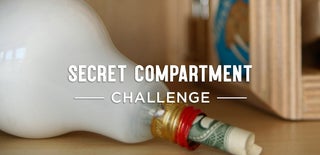Introduction: Oak End Table With 3 Hidden Compartments
I found an article in Woodcraft magazine October 2019 on building an end table with secret compartments I wanted to make this table from material I had one hand.
Step 1:
Examining the plans I decided that I would make some modifications. I wanted all latches to be manual no electrics with batteries that could run down. I also wanted to access the compartment under the lid without removing objects on top. The hinged top was replaced with a full extension draw slide. I also replaced the RFID latch with a manual bolt latch. The side panel pivot hinges were replaced with a piano hinge.
A law enforcement friend of mine recommended to put the drawer on metal slides so that it could not be removed easily. He said in most burglaries the drawers are pulled out and emptied looking for hidden valuables.
Attachments
Step 2: Table Was Made From Repurposed Materials
The table was totally made from repurposed materials. The only specially purchased parts were the drawer slides.Several of the dimensions from the Woodcraft plans were change because of available materials.
The legs were made from off cuts of oak purchased for a cider press restoration. That restoration was documented in the listed instructables. https://www.instructables.com/id/Making-Dimensiona...
The top and drawer front were made from a open package of oak flooring purchased at a garage sale for $2.00. The same material was used in a 4 foot long coat rack with a shelf and drawers, and enough material is left for 2 more table tops.
The sides were made from a damaged teachers desk that was made from solid oak. The bottom file drawer was used for the table sides and drawer sides. The dovetail joints in the file drawer were heated with a heat gun and pressure was applied.(reversed a speed clamp) The desk had been dropped and the front legs were broken off. The top was cut in half the long dimension and used for 2 workbench top. Purchase price for the desk was $1.00.
The drawer bottom is the file drawer bottom.
The inner frame were pieces from the scrap bin.
The bolt latch was from a box of junk purchased at an auction.
The push latches, drawer pull, and piano hinge were salvaged from a water damaged mdf entertainment center.
Step 3: Dowel Joints Were Used Instead of Mortise and Tenon
I personally like dowel joints instead of mortise and tenon, The parts are cut to length, I use stop blocks so all matching parts are identical. The dowel joint jig register from the end and face, so the registering face will be flush, verse the centering type dowel jig that centers the dowel and if the material is not the same thickness the parts do not line up.
Pocket screws are used to draw the parts together. Glue is applied to the joints before final assembly.
The construction was typical furniture making. The only special operation was the hinges panels. These panels were cut long and trimmed to size after the table was assembled.
Step 4: Lining the Drawer and Secret Compartment
The drawer and secret compartment have a cloth lining on the bottom. I prepare the cloth by gluing it to card stock. (manila file folders) Rubber cement or contact adhesive is used. A coat is applied to the card stock and allowed to dry, The cloth is then is applied to card stock and then a hard rubber roller is used to press the cloth into the adhesive. The cloth is then fitted to the drawer bottom and secret compartment. After fitting the card stock is glued to the drawer bottom and secret compartment.
Step 5: Details of Hardware Installation
The hardware installation will very depending on the hardware used.I have included close up photos for the hardware I used.
The push larches, after opening, the dual latches have to be manually reset and then the side panel is closed.
The panel stop cables are 1/16" steel cable (off a garage door) and electrical connector. After crimping a drop of super glue is applied to keep the steel form pulling out.
The bolt latch is installed on one side, I chose the side next to my chair. Installation includes drilling a blind hole on the bottom of the table top. The location is established by the latch. after the hole is located the latch is installed so it can be locked in the upper notch.
The piano hinge is cut to length and and installed to the side panel and a spacer piece fitted to the gap between the inner panel and the side panel.
The drawer slides on the top cause a 1/2" space between the top and the side panel. 1/4 round molding fitted to hide the gap. The oak pieces were made on the router table with a round over bit. The molding is attached to the side panel, smaller pieces are attached to the top and back leg. The front piece is attached to the bottom of the sliding top.
The drawer pull is installed in the center of the drawer.
Step 6: Finished
The table was stained with a honey oak stain and 4 coats of fast drying urethane varnish were applied.
The main compartment and two side compartments can be accessed with items on the table, and the compartments can hold medications, valuables, or emergency equipment..

Participated in the
Secret Compartment Challenge












